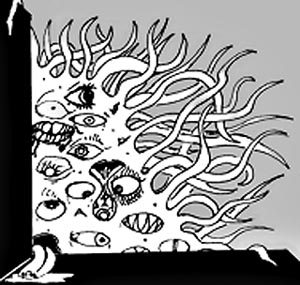![[MetroActive Features]](/features/gifs/feat468.gif)
![[MetroActive Features]](/features/gifs/feat468.gif)
[ Features Index | San Jose | MetroActive Central | Archives ]
 Illustration by Jeremy Russell Cthulhu and You Deep inside a geek's mind EVER WONDERED WHY so many geeks are obsessed with the Cthulhu mythos? Maybe you don't know what Cthulhu is, but if you're a geek or live among the geeky, chances are you've heard vague references to a slimy, tenticular, deep-sea dark force known as Cthulhu (pronounced kuh-thew-loo). You could have heard about it from the popular role-playing game Call of Cthulhu or from a bit of bad fantasy horror fiction you read once. Fact is, Cthulhu imagery is everywhere in geekdom. There's even an O'Reilly T-shirt that features a menacing, squidish beast identified as Cthulhu attacking Microsoft. And have you ever plugged the word Cthulhu into any search engine? It will return about a zillion hits from all over the world. Like Star Trek, the Cthulhu mythos has become a deeply meaningful geek touchstone. Cthulhu, also known as the Deep One, is a monstrous, chaotic force (often depicted as a squid) dreamed up by infamous pulp writer H.P. Lovecraft back in the 1920s. Until his untimely death in the early 1930s, good old H.P. (Howard to his buddies) used to stay up every night--in true proto-geek form--drinking coffee, eating candy and writing scads of bizarre sci-fi horror stories for Weird Tales magazine. Sleeping far beneath the ocean, Lovecraft's Cthulhu is part of an ancient, intelligent race whose minions (the Deep Ones) colonized Earth long before humans evolved. When Cthulhu awakens--as he does in Lovecraft's short story "Call of Cthulhu"--he causes humans to dream of geometrically incomprehensible cities, pre-human forms of icky sex and other "eldrich horrors." Anyone who beholds him is driven utterly, completely, wildly insane. There are a lot of insane characters in Lovecraft's stories, and Cthulhu or his spawn are often at the bottom of it. That's where geeks and their lives come in. Among the geekish tribe, Cthulhu has become a sort of a symbol for the dark side of science. He is the hidden, chaotic force that drives all forms of tech innovation and the destroyer of human sanity when scientific rationality breaks down. References to Cthulhu and Cthulhu-like creatures are everywhere in the geek world. The other day, my friend, Stu (a fabulous deep backend coder for Juniper), was talking about the habit many old-time hackers have of inserting a particular warning comment into a truly ugly, slimy piece of inexplicable code. The warning reads: "Here there be dragons." Beneath the perfect algorithms, under the binary seas, there lurk enigmas so impossible that they might as well be magical beasts. Although science is supposed to be a clean, straightforward way of doing things and seeing the world, it's actually a pretty messy, intuitive business. And that's a little scary, not to say maddening. Unlike, say, Monty Python--the geek muses of joyous chaos--Cthulhu represents a dark, unhappy part of the chaos which is computer science. Although Wired magazine and those misguided guys who wrote The Long Boom are convinced that everything technologically driven will turn out sunny and covered in money, tech is only as good as the people who wield it. In the wrong hands, tech equals weaponry, egregious biological experimentation and the reduction of human beings to mere "symptoms" or "case studies" or "users." Not to be too melodramatic, but science can create monsters. And Cthulhu is one such monster. In one of my favorite Lovecraft short stories, "The Shadow Over Innsmouth," a bookish young man (very geeky) discovers a tiny New England town called Innsmouth whose inhabitants have been breeding with Cthulhu's spawn. The results are a group of weirdly fish-like people who worship bizarre sea gods and spend most of their lives underwater. At the end of the story, our horrified narrator begins to grow gills and discovers that he, too, is a spawn of Cthulhu. Babbling in the language of the Deep Ones, he flees a mental institution (of course) and sets off to join his family under the sea. The moral? The monsters you imagine aren't in your code: They're in you. You figure it out.
Annalee Newitz (tabloid@jps.net) is a surly media nerd who has read way too much Lovecraft. [ San Jose | MetroActive Central | Archives ]
|
Copyright © 1999 Metro Publishing Inc. MetroActive is affiliated with the Boulevards Network.
For more information about the San Jose/Silicon Valley area, visit sanjose.com.